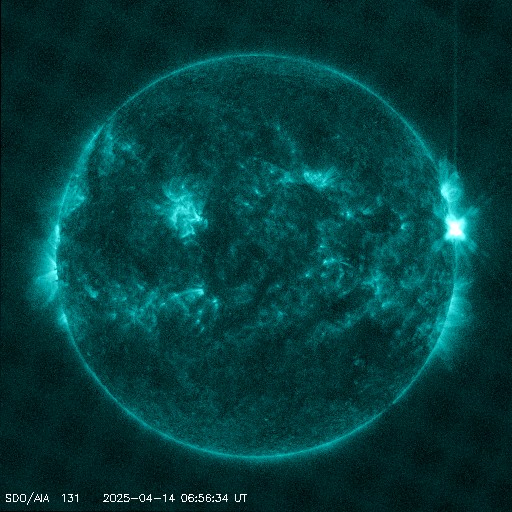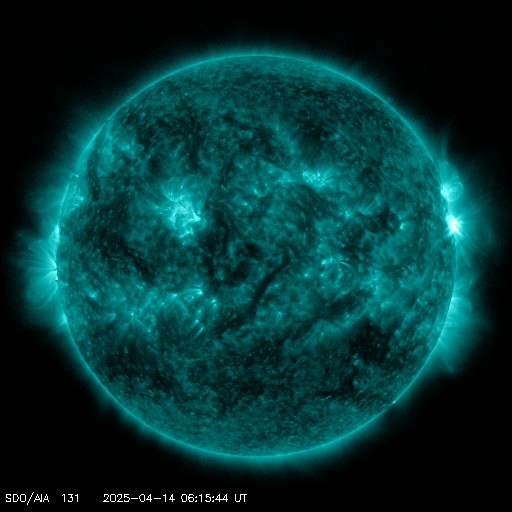Viewing archive of Tuesday, 3 April 2001
Solar activity report
Any mentioned solar flare in this report has a scaling factor applied by the Space Weather Prediction Center (SWPC). Because of the SWPC scaling factor, solar flares are reported as 42% smaller than for the science quality data. The scaling factor has been removed from our archived solar flare data to reflect the true physical units.
Report of Solar-Geophysical Activity 2001 Apr 03 2200 UTCPrepared by the NOAA © SWPC and processed by SpaceWeatherLive.com
Joint USAF/NOAA Report of Solar and Geophysical Activity
SDF Number 093 Issued at 2200Z on 03 Apr 2001IA. Analysis of Solar Active Regions and Activity from 02-2100Z to 03-2100Z
Solar activity has been high. Region 9393 (N18W82)
produced a spectacular flare beginning at 02/2132Z, reaching maximum
at 02/2151Z and ending at 02/2203Z: the peak of the event saturated
the GOES-XRS sensors, but was estimated to be X20, the largest
observed so far this solar cycle. A fast coronal mass ejection (CME)
was observed in association with this event. The CME appeared to be
primarily headed off the west limb, but there was a deflection of
material near the north polar region, suggesting that the event
trajectory might have some earthward component. In the LASCO-C3
coronagraph images, this CME was overtaking the previous CME
associated with yesterday's X-class event from the same region.
Region 9393 also produced an M2/2f flare at 1234Z. The leading spots
of 9393 are currently rotating off the solar disk. Newly assigned
region 9415 (S22E72) produced an X1/1n flare at 0357Z. The event was
also associated with a CME which has the signature of a partial halo
event, although the bulk of the material appears to be flowing in a
southeasterly direction. So far Region 9415 is showing three large
penumbral clusters with an area of about 470 millionths. Solar
observers report that additional spots are rotating into view behind
this leading section of the region. Two new regions emerged on the
disk today: Region 9416 (N17W18) and Region 9417 (S10E43). Region
9408 (S08W46) showed some growth during the past 24 hours but was
relatively stable.
IB. Solar Activity Forecast
Solar activity is expected to be high.
Region 9393 will continue to be a threat for major flares and proton
events during the next three days, although the probabilities will
decrease as it rotates around the solar limb. Region 9415 has also
clearly shown major flare potential and is expected to be a source
of M-class flares and probably additional isolated X-class flares.
IIA. Geophysical Activity Summary 02-2100Z to 03-2100Z
The geomagnetic field ranged from quiet to active levels. Quiet to
unsettled levels prevailed for most of the day, but there was an
active period from 02/2100-2400Z. An energetic proton event resulted
from the X20 flare. Greater than 10 MeV particles exceeded event
threshold at 02/2340Z, and reached a maximum of 1,110 PFU at 0745Z.
The 10 MeV particle event continues in progress with 308 PFU at
forecast issue time. Greater than 100 MeV particles also exceeded
thresholds, beginning at 03/0120Z, reaching maximum of 5.4 PFU at
03/0740Z, The greater than 100 MeV particles dipped below threshold
around 03/1900Z and appeared to be staying below threshold as of
03/2050Z.
IIB. Geophysical Activity Forecast
The geomagnetic field is
expected to increase to minor to major storm levels during the next
24 hours. The two recent CMEs from region 9393 are likely to have
combined by now, and the size and possible partial earthward
component of the 2nd CME create the expectation of some interaction
at Earth. The response is less certain than in the case of a
full-halo CME and probably less dramatic than the result of a
direct, head-on hit. The forecast is for minor storm levels at the
mid-latitudes, with major storm levels at the higher latitudes.
Minor storm conditions are expected to persist through the second
day. Additional activity, most likely reaching active levels, is
possible on the third day due to a glancing blow from the CME from
region 9415. The greater than 10 MeV proton event is expected to
persist through most of tomorrow.
III. Event Probabilities 04 Apr to 06 Apr
| Class M | 85% | 80% | 70% |
| Class X | 35% | 30% | 20% |
| Proton | 99% | 30% | 15% |
| PCAF | in progress | ||
IV. Penticton 10.7 cm Flux
Observed 03 Apr 223 Predicted 04 Apr-06 Apr 215/205/195 90 Day Mean 03 Apr 166
V. Geomagnetic A Indices
Observed Afr/Ap 02 Apr 012/020 Estimated Afr/Ap 03 Apr 010/012 Predicted Afr/Ap 04 Apr-06 Apr 035/060-035/040-020/020
VI. Geomagnetic Activity Probabilities 04 Apr to 06 Apr
| A. Middle Latitudes | |||
|---|---|---|---|
| Active | 35% | 35% | 35% |
| Minor storm | 30% | 30% | 15% |
| Major-severe storm | 25% | 15% | 10% |
| B. High Latitudes | |||
|---|---|---|---|
| Active | 25% | 25% | 25% |
| Minor storm | 35% | 35% | 20% |
| Major-severe storm | 35% | 30% | 15% |
All times in UTC
Current data suggests there is a slight possibility for aurora to appear at the following high latitude regions in the near future
TórshavnOulu, Rovaniemi
Reykjavik
Trondheim
Luleå
Latest news
Latest forum messages
2025/04/12-13 Filament CMEs 2025/04/16 G2 Watch 38Incoming & Unnumbered Active Regions 1700Unspecified geomagnetic activity 2258AR 4055 98Potential AR4062 8
More topicsSupport SpaceWeatherLive.com!
A lot of people come to SpaceWeatherLive to follow the Sun's activity or if there is aurora to be seen, but with more traffic comes higher server costs. Consider a donation if you enjoy SpaceWeatherLive so we can keep the website online!

Latest alerts
23:15 UTC - Geomagnetic activity
Active geomagnetic conditions (Kp4) Threshold Reached: 23:01 UTC
07:09 UTC - Solar flare
Moderate M4.28 flare from sunspot region 4055
06:48 UTC - Radio Blackout
Minor R1 radio blackout in progress (≥M1 - current: M1.53)
06:24 UTC - Solar flare
Moderate M1.49 flare from sunspot region 4055
06:06 UTC - Radio Blackout
Minor R1 radio blackout in progress (≥M1 - current: M1.16)
Space weather facts
| Last X-flare | 2025/03/28 | X1.1 |
| Last M-flare | 2025/04/14 | M4.2 |
| Last geomagnetic storm | 2025/04/06 | Kp5 (G1) |
| Spotless days | |
|---|---|
| Last spotless day | 2022/06/08 |
| Monthly mean Sunspot Number | |
|---|---|
| March 2025 | 134.2 -20.4 |
| April 2025 | 132.1 -2.1 |
| Last 30 days | 130.6 -13.6 |





